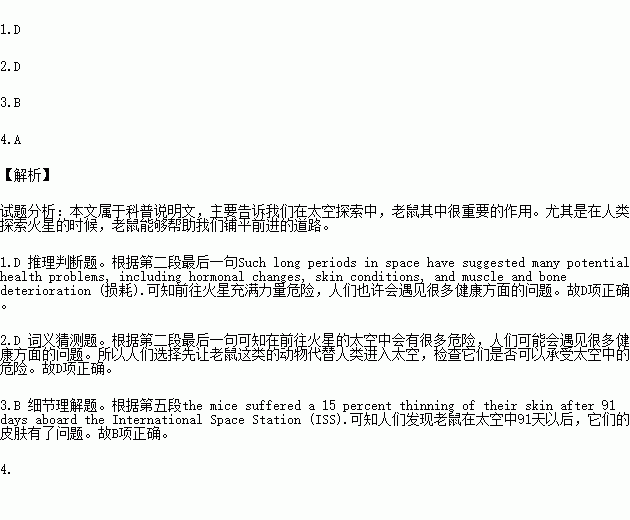题目内容
Humans have launched themselves into the outer space. They’ve landed on the moon. They’ve built habitable space stations that orbit the Earth. The next giant leap for mankind is to reach another planet – specifically, Mars.
The problem is that it’s no easy task. The planet is 586 times further away from the Earth than the moon, and it’ll take around 180 to 220 days to reach Mars, depending on where each planet is in its orbit. Such long periods in space have suggested many potential health problems, including hormonal changes, skin conditions, and muscle and bone deterioration (损耗).
Here’s where some furry friends come in. A wide range of animals have been in space, from fruit flies and spiders to cats, and dogs. Such experiments began as far back as the late 1940s in first tests to see if living things could withstand the extreme g-force (重力) of a rocket launch.
Mice continue to play a very important part in space experiments, mainly because the animals make excellent test subjects. They’re small, which makes them inexpensive and easy to care for. In addition, their size and short life span make it possible to do the equivalent of several human years of tests in a much shorter time. Finally, because mice are mammals, they share many common characteristics with humans in terms of genetics, biology and behavior.
Astromice have hit the headlines recently, as a team of scientists led by Betty Nusgens, professor of biology at the University of Liege in Belgium, found that the mice suffered a 15 percent thinning of their skin after 91 days aboard the International Space Station (ISS).
This experiment was part of a wider NASA mission (任务) called the Mice Drawer System (MDS). The Italian Space Agency developed the facility, which allows six mice to be housed, monitored, and automatically fed and watered aboard the ISS, among which three survived during the mission.
The mice have participated in 20 separate experiments, to study such effects as osteoporosis (骨质疏松症), anemia (贫血) and heart health.
Results for the 20 experiments are coming in gradually. But it’s clear that mice continue to play an important role in the ongoing quest to conquer the final frontier.
1.We can infer from Paragraphs 2-3 that ______.
A. Mars is the farthest planet away from Earth discovered so far
B. animals that have been sent into space have mostly survived
C. it was in the late 1940s that animals were first sent to the ISS
D. the journey to Mars could put humans’ health at risk
2.The underlined word “withstand” in Para.3 means _________.
A.set up B. come across
C. work out D. hold up
3.According to Betty Nusgens and her team, the mice aboard the ISS ______.
A. all survived for the duration(期间) of the mission
B. suffered the loss of part of their skin
C. were fed and watered by the astronauts
D. participated in 20 experiments that made great breakthroughs
4. The main purpose of the article is to _____.
A. analyze how mice could pave the way to Mars
B. report on the results of the Mice Drawer System
C. describe the role mice play in scientific research
D. change people’s traditional attitudes toward mice

